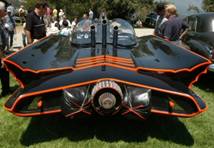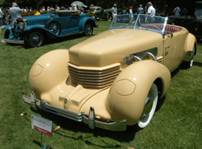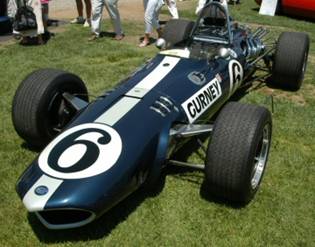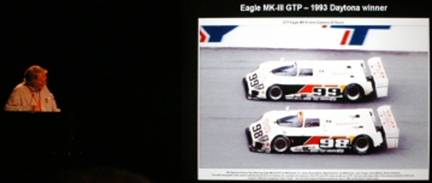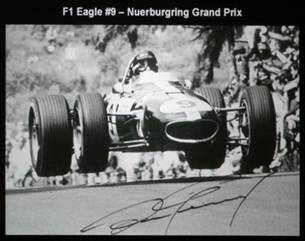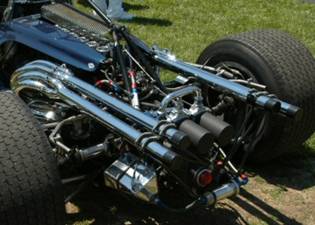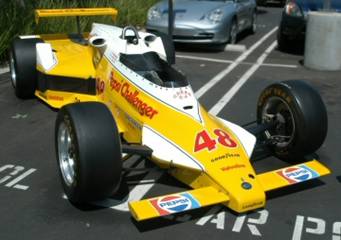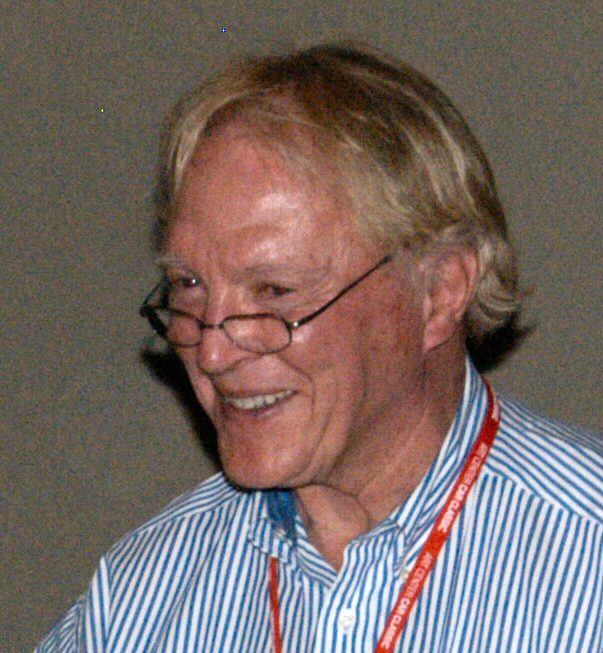
2004 Art Center Car Classic (part 2): Dan Gurney on Racing and the “BLAT” Effect
Last week I started to tell you about the annual car show at the Art Center College of Design in Pasadena. There was too much for one column so here is part two.
As you may recall, the theme was “Supercars: Past and Present.” In addition to some pretty incredible (and very accessible) cars on display, several automobile designers shared their wealth of knowledge and experience with us. I saved a real treat for today: excerpts from the talk by racing legend Dan Gurney, presented with his charming sense of humor. By the end he had the crowd doubled over in laughter.
Dan started by thanking the Art Center for inviting him to spend 30 minutes telling us about 40 years of accomplishments. We laughed.
Then we were shown pictures of some of his famous racecars in front of his Southern California factory, which he referred to as “Maranello South” (Maranello being the Italian home of Ferrari). He showed us his famous Formula One car that won the Belgian Grand Prix in 1967, which set a lap record in the process.
(photo taken of Dan Gurney’s slide show)
Dan expressed pride in his Toyota GTP car, “conceived, designed, built and campaigned by our company, All American Racers, in Santa Ana, California.” “It was powered by a little four-cylinder turbocharged Toyota engine of 2.14 liters and with it we went up against the best, including Porsche, Ferrari, Jaguar and Nissan.” “To make a long story short, we won the last 17 races that we entered. That included the Daytona 24-hour race and two Sebring 12-hours in an 18-month period, so we proved it was a pretty good car.”
We were reminded that “our cars are all called Eagle racing cars.” An “Indy Eagle from 1981 has a stock block sort of a Chevrolet sprint car engine in it that we helped develop.” The last Indy Car that they made was Toyota-powered. One that was driven at Fontana in 1998 was on display at the Art Center show. It turned a lap at 232 mph during practice.
Dan addressed the subject of his design contributions by saying “when I’m called a designer I sort of blush a little bit because although I have a lot of interaction with the designers, I really wasn’t good at drawing. But discussing the concepts and what we were trying to achieve became very important to me.”
As he recalled, one year in the mid-60s he qualified sixth at Monaco in the Gurney-Weslake 12-cylinder, 3-liter Formula One car. At the end of four laps he was already in third place. Unfortunately he had a mechanical failure.
Another Eagle held the lap record at the Nuerburgring for two years. He said “on a lap in those days, a record lap, it would be all four wheels off the ground in four different places on the track!”
“The Weslake company did a great job on our engines. We were very, very handicapped in terms of budget. They could do maybe four or five miracles a week. It was pretty hard to get the sixth in but they often did!”
Dan entertained us with a story about his participation in the 1966 Indianapolis 500. As you read this keep in mind that Indy used to be famous for the drama of its qualifying days before the actual race. Back before the mid-90s split between CART and the IRL, being “on the bubble” was nerve racking to watch, let alone be a part of.
“I didn’t have such good luck on that occasion. I didn’t quite get to the first turn. We had a major wreck and I’d gotten involved in it. I think the people who had qualified quickest on the day before, or on qualifying on first day, didn’t get involved in the wreck, but we had made three attempts on first day and the clutch was slipping each time, so I had to abandon it. Therefore when I started I was probably starting eleventh or twelfth and I got involved in the wreck.”
Speaking of the 60s, “initially wings were not allowed.” They create downforce. “Things were starting to get lower and wider. (If) you have a very tall car going around a corner very fast … you don’t get much help on the inside tires going around a corner. If you have a low CG (Center of Gravity) you get all four tires working pretty well. That’s basically what we were reaching for.
“All these cars were funded by Goodyear Tire & Rubber Company. In ’64 they had gone to Indy for the first time in a long time and they showed up on raceday. No one was on a Goodyear and they realized that something was going wrong. That’s when opportunity knocked as far as we were concerned. They wanted to have cars that they were certain would be on Goodyear tires and would we help them? So Carroll Shelby came and asked me, and I said yes we will and we put together this effort.”
With regards to the now commonly used “Gurney flap,” it was born out of a “necessity is the mother of invention kind of situation.” “The necessity came when we had been in Phoenix for about three days, hot as the Dickens, and we were stuck. We couldn’t go any faster than we had gone in the first day. Bobby Unser challenged me. He said:” “Boss, you’re supposed to be able to come up with something. Can’t you come up with anything, for crying out loud?” “And I remembered having spent a lot of time with these little tabs on the back, or spoilers and so forth, and I thought to myself – well, I wonder if one would work on a wing? We already had wings on these in 1971. Sure enough, that was the beginning of the Gurney flap.”
“In ’71 at Indy, which was the sort of hotbed of development in the States, the McLaren team came with an Offy-powered car. Historically the Indy speeds increased at about an average of 1½ miles per hour per year. Then all of a sudden the McLaren came and they put either 13 or 14 miles an hour in one shot and everybody was obsolete. Our reaction was, well what do we do now, you know?
We ended up making a car where we sort of had to roll the dice, not be too conservative and go for even lower cg if possible, and better cooling if possible – a very robust car in terms of the right gear and the wheels and the axles and the hubs.” “(With) the ’72 Eagle, to make a long story short, we ended up putting another 13 or 14 on top of the McLarens – sort of ‘I’ll see you and raise you.’ It was a huge breakthrough and by ’74, 20 or 21 cars out of the fastest 33 qualifiers were Eagles. We thought we were really terrific. Of course we were selling them at a loss. Each one (laughter)! We were racers, not businessmen.” In ’74 we ended up winning the national championship – Bobby Unser at the wheel.”
By the way, Jerry (Grant), in this car at Ontario (in 1972), became the first driver in history to average over 200 miles an hour for a four-lap run – for what’s that? Ten miles. Bobby has never forgiven him for doing it. Bobby did it the next day. He put a little bit more on it. We were definitely riding high at that time.”
“On a qualifying run the most boost we could get was about 141 inches. It made over 1,000 horsepower doing that. I remember at one time Bobby said:” “Boss, you’ve got to drive this thing.” “Of course, I’d been out of the cockpit for a long time. I said okay. We were at Ontario and it had a gear that would run, oh, 230 miles an hour. I stepped on it in that tall gear and it accelerated like it was in second or something. It would just really pin you back into the back of the seat. It was pretty smooth. You really felt like you were really in an elevator – just whoosh like nobody’s business.”
“All our designers were very, very good.”
“Normally these cars were all involved in what they called ‘ground effects.’ Well, ‘ground effects’ – the term, was there long before racing cars were using it. It was part of what happened when you brought an airplane in. As you got closer to the ground it gained some lift as it was trying to compress the air into the ground. So it sort of pillowed and you had to slow down a little more than you expected in order to land. “It was doing just the opposite of what you wanted to. If you’ve (got a) racing car you want it to be pulled down on the ground to give the tires more traction. So, we came up with a term called the ‘BLAT’ effect. You see, we’re not using ‘ground effects,’ we’re using ‘BLAT.’” “Well wait a minute, what do you mean ‘BLAT?’” “Battery layer Adhesion Technology.” “It was supposed to be funny (at that the audience laughed loudly).” “Anyway, all these other old-fashioned guys were working with ‘ground effects’ and, of course, we had ‘BLAT.’”
“One of the things that we found we had to do all the time was somehow attract enough money – the budgets, to do all this wonderful development work. We were getting pretty close to not having enough, and Mike (Mosley) – I feel funny because I know the clock is ticking and I shouldn’t have started this story, but anyway – he started (the 1981 Rex Mays Classic on the Milwaukee Mile) from the last position or what they call a ‘promoter’s option.’ He passed every single car on the track and won it going away, with this car. You’ll see it up there, up above the display area. You ought to take a look at it because it’s really different – and you’ve probably never seen a car with a ‘BLAT’ effect (lots of laughter)!”
I’ll end this with a humorous story about a long-popular part of racing tradition, as told by Dan Gurney. This was not part of his planned presentation. Rather, it began with this question from a member of the audience: “What prompted you to spray the champagne on the podium? I heard that you were the first one to spray champagne all over everybody on the podium. I want to know why.”
“I think that was my tenth attempt at the LeMans race and we had worked really hard for it. It was such a huge event. We were up on a platform as part of the celebration and the driver crews (were) below. They were looking expectant, you know, and I couldn’t speak much French and so forth. It just seemed like we should do something (laughter) and all of a sudden I emptied this magnum of champagne. I figured, well, first I’ll just use it like a fire hose. I got all the photographers and ruined all their lenses (lots of laughter). I still had plenty of ammo left so I got everybody on the platform, too (lots more laughter), including Henry Ford the second. So it was just spur of the moment. I hadn’t planned it (huge laughter and applause).
On that happy note, I’ll end this year’s coverage of the Art Center Car Classic. Do attend next year’s. For more information on the Art Center College of Design, visit www.artcenter.edu.
Drive safely and do join me again next time.

